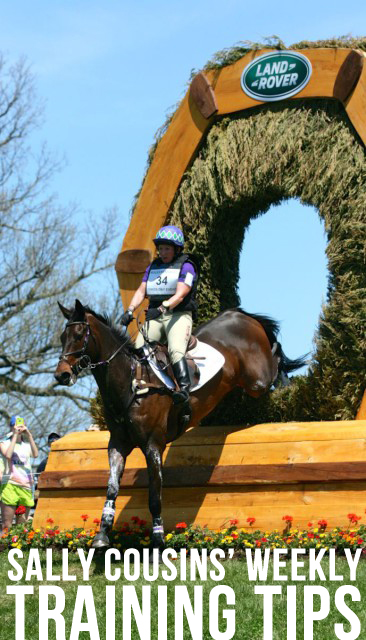With the winter enveloping us, it’s the perfect time to sit back and contemplate how to achieve greater success in 2018 in our lives with horses. As riders, we never stop questing for improvement and learning how to be a better horseman is a lifelong journey. Sally Cousins has more experience in her little finger than many of us can hope to ever garner, and she’s delighted to be part of our Winter Training Tips series, hoping to inspire and educate with little nuggets of wisdom.

Sally Cousins and Tsunami. Photo by Leslie Threlkeld.
We all have strengths and weaknesses, as do our horses — how we improve is to work on our weaknesses. It is tempting to follow current trends in training our horses and it is often unpopular as an instructor to be telling students things they are not hearing elsewhere.
If your horse has a short stride and jumps comfortably that way, our work with that horse should be to lengthen the stride and work on medium distances. The whole point of course design is to test our horses out of a variety of distances that require many different canters. The majority of the lines in show jumping are at 12 feet. If your horse prefers a 14-foot stride and leaving the ground off an open distance, then practicing the small canter to a waiting distance makes sense.
If your horse is most comfortable at a 10-foot stride and jumping from a short distance, then working to make the horse travel on a 12-foot stride without it feeling like you are galloping at the jumps is important. We need to teach them to lengthen in a relaxed manner so they don’t get frantic when we have to jump through a combination set slightly long.
If your horse’s strength is cross country, and its weakness is dressage, it is important to get more instruction for that phase. (Having said that make sure you have schooled any new cross country questions you might see if you plan to move up.) If show jumping is difficult for you or your horse, spend more time on jumps in the ring. One note about instructors who are strictly dressage or show jumping trainers: I find it helpful if they have an understanding about eventing and how the phases relate to each other.
It is helpful to go to dressage and jumper shows, especially if you or your horse gets nervous in the ring. It is important to remember that this is good practice but it does not take the place of having an instructor help you develop a new skill set!
As riders and trainers we need to develop the “tools in our tool box” so that when we are faced with a training issue, we have many things to try if the first one doesn’t work. If you work with an experienced trainer they may have four or five things to try next!

























